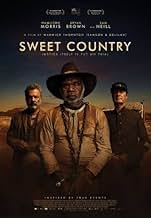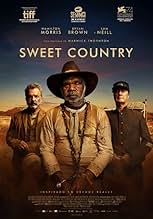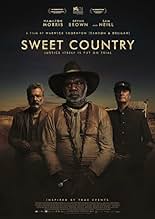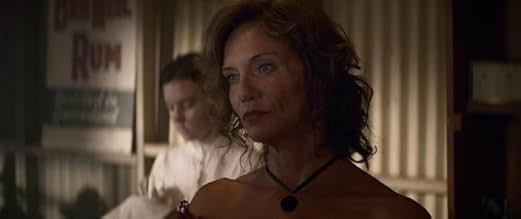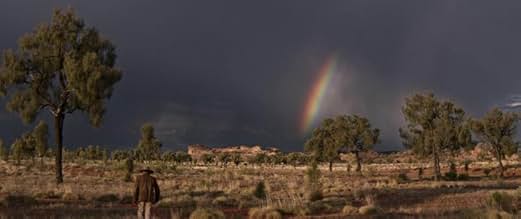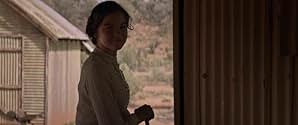VALUTAZIONE IMDb
6,9/10
9814
LA TUA VALUTAZIONE
Sulla frontiera del Territorio del Nord negli anni '20, la giustizia stessa viene processata quando un anziano contadino aborigeno spara a un uomo bianco per autodifesa e va in fuga mentre u... Leggi tuttoSulla frontiera del Territorio del Nord negli anni '20, la giustizia stessa viene processata quando un anziano contadino aborigeno spara a un uomo bianco per autodifesa e va in fuga mentre una banda si riunisce per dargli la caccia.Sulla frontiera del Territorio del Nord negli anni '20, la giustizia stessa viene processata quando un anziano contadino aborigeno spara a un uomo bianco per autodifesa e va in fuga mentre una banda si riunisce per dargli la caccia.
- Regia
- Sceneggiatura
- Star
- Premi
- 22 vittorie e 29 candidature totali
Natassia Gorey Furber
- Lizzie
- (as Natassia Gorey-Furber)
Lachlan J. Modrzynski
- Constable Campbell
- (as Lachlan Modrzynski)
Recensioni in evidenza
When Australian cinema is good ,its usually really good and this one can hold its head high in any cinema in the world.
Director Warwick Thornton who also made Samson and Delilah has excelled again with this Aussie period Western set in 1929 in the Northern Territory.
It has the feel and ingredients of a Western , the Lawman, the fugitive, the posse, even the Saloon gal and the town vigilantes but Its much more than an action Western and even reminded me at times of Harper Lee's To Kill a Mockingbird set in the Australian outback.
The stars are Hamilton Morris as Sam the hunted fugitive Aboriginal stockman and Bryan Brown as Sergeant Fletcher the hunter .
Sam Neill as the minister, is also terrific in his role , showing the only compassion and acceptance to the indigenous population in the entire movie and Matt Day as the judge is also impressive.
The cinematography is superb and at times resembles an Albert Namatjira landscape, which is understandable but it takes great skill to capture the light and timelessness of the outback landscape, it should wow overseas audiences .
After the dismal film we saw yesterday this was a joy to watch and what good cinema is all about.
I've read here two reviews by Australians, one hated the film, the other loved it. I've seen the film in the company of two other Australians, they both loved it.
Yes, I agree to the point made, by the hating reviewer: the movie does judge the past according to modern morals and sensibilities. But this would be a valid point if we were discussing an academic paper or a movie that was made back then. This is neither it's a movie about Australian past that was made at the present and it feels so true it hurts. It hurts because the only way we can see it is with our modern eyes. Saying people thought differently back then, is true but it's beside the point. We, the viewers are here and now and that's the only time and place we can watch it.
So lets speak about other aspects of the film: cinematography, acting and story telling are superb. But I liked most of all the editing, with these tiny flashes forward and backward throughout the movie, flashes we can fully understand only when we've seen the movie all the way through. Please do, I think you won't regret it.
So lets speak about other aspects of the film: cinematography, acting and story telling are superb. But I liked most of all the editing, with these tiny flashes forward and backward throughout the movie, flashes we can fully understand only when we've seen the movie all the way through. Please do, I think you won't regret it.
I saw this film on 25th January with my granddaughter who is Aboriginal. Most fitting on the eve of the last day of freedom for Indigenous people. A very moving film that brought home and really reminded us of the cruel and widely hidden history of this country. Should be compulsory viewing for all high school students and used as a starting point for students to explore and examine their local Indigenous history. I hope to be able to buy a copy in the near future.
When a good cinematographer gets behind a movie landscapes reveal all their beauty and possibilities, and movies become as much about art as about a story. Such is the case here. The story itself is a very real example of what aboriginals in Australia must have suffered for decades. As such it is a most important document. The story is more than that though, and is a very sober and insightful look at the depth, or lack of depth, in people's characters, both for the oppressed and the oppressors. And it has some surprising moments, is genuinely authentic, and leads us to a very real hero. Fantastic performances by all the cast, this is a very fine example of Australian film.
Using the Hollywood label 'western' for an Australian outback drama casts an odd cultural shadow over the achievements of Sweet Country (2017). At a Q & A preview in Sydney, director Warwick Thornton told the audience "people think in boxes so we need to call it something". However, 'western' is an awkward box for an Australian tale of such contemporary relevance and cinematic beauty.
Set in 1920s outback Northern Territory, the narrative is deceptively simple. Indigenous farm hand Sam Kelly (Hamilton Morris) and his wife are lucky to work for god-fearing landowner Fred Smith (Sam Neill) who believes that all are created equal. Fred allows Sam to help his unstable war-veteran neighbour Harry March (Ewan Leslie) for a few days but it sours quickly and Sam kills Harry in self-defence. The rest of the story tracks the hunt led by Sergeant Fletcher (Bryan Brown) through treacherous country that is home for Sam. Eventually white man's justice must be faced.
This is an outstanding film for many reasons. In terms of visual impact, it is stunning. The cinematography shows a deep love of country with majestic panoramas that dwarf humans. Rich red colour palettes evoke the hot, dry, heartland of an ancient land. The camera tracks seamlessly from wide-screen images to small details like a balletic sand scorpion or a cold hard bullet being loaded into a chamber. Scene after scene, we find symbols of the conflicted relationship between white man and nature; there are no words more jarring than to hear Indigenous people being referred to as "black stock".
In terms of aural impact, silence has never been so beautiful. It takes some time into the film before we notice there is no musical score, and none is needed. As Thornton put it, when you stand in the desert there are no orchestral violins to tell you what to feel. Silence conveys the outback. You hear the rustle of leaves in the wind, the sound of a flowing river, horses' hooves pounding the ground, and most confronting: the sound of a heavy chain being dragged across desert sand, manacled to the black hand of a fleeing Indigenous youth.
The casting is excellent. Bryan Brown and Sam Neill are almost cameo performers in their roles as hard-core outback characters. The emotional centre of the film, however, is Hamilton Morris. He speaks little and emotes even less. His face is a wide, impassive, deeply etched, and painful canvas that speaks of Indigenous people's dispossession and barbaric mistreatment by armed invaders. Views will differ over whether the Johnny Cash cowboy ballad during the credits makes this more or less of an Australian story. This powerful but disturbing film reminds Australians of our history and need to reconcile with the past.
Set in 1920s outback Northern Territory, the narrative is deceptively simple. Indigenous farm hand Sam Kelly (Hamilton Morris) and his wife are lucky to work for god-fearing landowner Fred Smith (Sam Neill) who believes that all are created equal. Fred allows Sam to help his unstable war-veteran neighbour Harry March (Ewan Leslie) for a few days but it sours quickly and Sam kills Harry in self-defence. The rest of the story tracks the hunt led by Sergeant Fletcher (Bryan Brown) through treacherous country that is home for Sam. Eventually white man's justice must be faced.
This is an outstanding film for many reasons. In terms of visual impact, it is stunning. The cinematography shows a deep love of country with majestic panoramas that dwarf humans. Rich red colour palettes evoke the hot, dry, heartland of an ancient land. The camera tracks seamlessly from wide-screen images to small details like a balletic sand scorpion or a cold hard bullet being loaded into a chamber. Scene after scene, we find symbols of the conflicted relationship between white man and nature; there are no words more jarring than to hear Indigenous people being referred to as "black stock".
In terms of aural impact, silence has never been so beautiful. It takes some time into the film before we notice there is no musical score, and none is needed. As Thornton put it, when you stand in the desert there are no orchestral violins to tell you what to feel. Silence conveys the outback. You hear the rustle of leaves in the wind, the sound of a flowing river, horses' hooves pounding the ground, and most confronting: the sound of a heavy chain being dragged across desert sand, manacled to the black hand of a fleeing Indigenous youth.
The casting is excellent. Bryan Brown and Sam Neill are almost cameo performers in their roles as hard-core outback characters. The emotional centre of the film, however, is Hamilton Morris. He speaks little and emotes even less. His face is a wide, impassive, deeply etched, and painful canvas that speaks of Indigenous people's dispossession and barbaric mistreatment by armed invaders. Views will differ over whether the Johnny Cash cowboy ballad during the credits makes this more or less of an Australian story. This powerful but disturbing film reminds Australians of our history and need to reconcile with the past.
Lo sapevi?
- QuizThe film is based on a real life true crime murder case where an Aboriginal man was arrested and put on trial for murdering a white man in central Australia during the 1920s.
- BlooperUnder Australian law, an execution would not be carried out immediately (or the next day), as executions would need to be confirmed by the State Governor. There also be time allowed for appeals against the death sentence.
- Citazioni
Fred Smith: We're all equal here. We're all equal in the eyes of the Lord.
- ConnessioniFeatured in Sweet Country: Behind the Scenes (2018)
- Colonne sonoreDown at Long Point
Written and Performed by Damien Lane
I più visti
Accedi per valutare e creare un elenco di titoli salvati per ottenere consigli personalizzati
- How long is Sweet Country?Powered by Alexa
Dettagli
- Data di uscita
- Paese di origine
- Siti ufficiali
- Lingue
- Celebre anche come
- Dulce país
- Luoghi delle riprese
- Aziende produttrici
- Vedi altri crediti dell’azienda su IMDbPro
Botteghino
- Lordo Stati Uniti e Canada
- 104.297 USD
- Fine settimana di apertura Stati Uniti e Canada
- 8895 USD
- 8 apr 2018
- Lordo in tutto il mondo
- 1.810.021 USD
- Tempo di esecuzione
- 1h 53min(113 min)
- Colore
- Mix di suoni
- Proporzioni
- 2.35 : 1
Contribuisci a questa pagina
Suggerisci una modifica o aggiungi i contenuti mancanti



